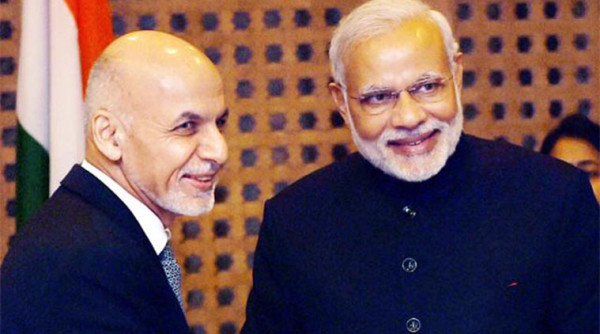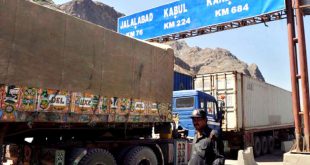By Mr. Shokrullah Amiri: SHOKRULLAH AMIRI, HEAD OF PRIVATE SECTOR DEVELOPMENT AT PRESIDENT OF AFGHANISTAN’S OFFICE WRITES ON THE IMPERATIVES TO IMPROVE AFGHANISTAN-INDIA BUSINESS LINKAGES
The objective here is to emphasize the imperatives to strengthen Afghanistan-India business linkages by relying on the friendly bilateral relationship, which is yet to prosper in terms of trade volume. It also includes policy recommendations and a guiding principle to deepen the bilateral and regional business linkages.
Comparing trade numbers
According to the World Bank’s WITS trade data for 2016 and 2014, Afghanistan’s top three trading partners were Iran ($1.26 billion), Pakistan ($1.19 billion) and China ($1.1 billion), while imports from India were just $152 million in 2016. While this represented a rise in the trading share from 1.4% in 2014, nevertheless it was still a mere 2.3% in 2016 – far less than what it should be given the friendly bilateral ties between Afghanistan and India. The trade volume between these two nations has the potential to achieve much higher numbers. This projection can be estimated at approx. $1 billion – closer to the Afghan-China and Afghan-Pak trade volume. Although Afghanistan does not share the border with India, a logistical handicap of sorts, there are still strong factors which justify this projection.
Factors that can drive this relationship
Afghanistan-India bilateral ties have matured. The trust at a political, cultural and economic level between their governments, people and businesses is firm. Afghan consumers place more trust on Indian products and services than those imported from the country’s three larger trading partners.
The Strategic Partnership Agreement (SPA) signed between the two countries in 2011 further strengthened this relationship. The SPA provides the broadest framework for improving economic relationships. Its focus economic sectors include Afghanistan’s infrastructure, education, investment into Afghanistan’s natural resources and provision of duty-free access to the Indian market.
Afghan people give more credit to the impact of the development projects implemented by India, rather than its other development partners. These projects include the Afghan-India Friendship Dam, Afghan Parliament building, electricity substations, the Kandahar Agro-Science & Technology University and the TAPI (Turkmenistan, Afghanistan, Pakistan, India) gas project. The two nations recently launched Air Cargo corridors to Delhi and Mumbai along with the establishment of the Iran-based Chabahar transport port project, the Afghanistan-India Trade and Investment show, and the Joint Working Group on Trade, Commerce and Investment.
All these are important steps providing a solid foundation to strengthen Afghan-India business linkages.
Potential investible sectors
There are six sectors wherein business linkages between Afghanistan and India could be deepened further. Afghanistan currently produces 600 megawatts of hydropower electricity, and there is a potential of producing up to 23,000 megawatts of hydropower. 3,000 megawatts suffices for its own domestic needs while the remainder can be exported to the regional countries. Next, it has been reported that more than $500 million flows out of Afghanistan for medical treatments and more than $800 million in pharmaceuticals are imported annually. That offers another investible sector.
There is huge potential in the cultivation and trade of Afghan horticulture, herbal and spice crops such as raisins, pomegranates, pistachios, almonds, licorice, cumin and saffron as well as hand-made carpets. Next, Afghanistan has lined up major infrastructure sector projects in its mid-term and long-term plans, including the National Rail and Road networks.
According to the Afghan government’s estimates, the value of the minerals Afghanistan possesses is worth $3 trillion. That offers ample scope in the mining sector. In 2016-17, the number of students registered for university entrance tests was 169,000, of which only 69% found their way to higher education institutes, while the remaining 31% were involuntarily left behind. This makes higher education another investible sector.
Policy recommendations
Afghanistan and India need to prioritize policy initiatives to deepen and widen their business linkages. The existing initiatives are fragmented and lack a comprehensive framework. The policies should provide incentives for cooperation. Only when a comprehensive study of the specific local situation has been carried out, can a linkage program be designed to match both countries’ business needs.
Maximum attention needs to be given to policies that align with market forces and that build on the mutual interests of both countries. These policy initiatives could include, but are not limited to, the establishment of dedicated business consulates and commercial offices, organizing matchmaking events at a company, industry and government level, encouraging international agencies for assistance, providing financial incentives to pioneer-businesses, and organizing dialogues and exposure visits, road shows, country-specific exhibitions. Also, India’s future development projects for Afghanistan should have business linkage promotion components.
In addition, the proposed policies should consider the wider scope to improve market linkages with Central Asia-based businesses, given Afghanistan geographic advantage. Recognizing the gap between the two least connected regions (i.e. South and Central Asia), Afghanistan and India are important players to improve the connectivity and regional economic growth. The TAPI and Chabahar projects will not only help transport goods and the energy resources of Central Asia to the energy-deficient markets of South Asia, but will also provide additional business linkage opportunities.
The recent news over America’s possible sanctions on Iran or its strategy towards Pakistan challenges these connectivity projects, hence it is all the more critical for both countries to lobby and protect their economic interests.
In conclusion, the governments in Delhi and Kabul are well positioned geo-economically and geo-politically not only to enhance regional economic integration but also to develop long-term policies to drive deeper bilateral and regional business relationships, thanks to the friendly relationship between the two nations which has now provided the better platform for both to realize the potential of their economic relationship.
Written by Mr. Shokrullah Amiri, Head of Private Sector Development and Outreach Department at the Office of the President of Afghanistan in Kabul. Previously, he worked on World Bank’s development projects
Follow us on Facebook, Twitter, Linkedin or Web to receive regular updates!
References:
World Integrated Trade Solution (WITS), World Bank, 7 Jun 2018,(accessed 7 June 2018): https://wits.worldbank.org/CountryProfile/en/Country/AFG/Year/2016/TradeFlow/Import
Ministry of Foreign Affairs of Afghanistan, 10 June 2018, (accessed 10 June 2018): http://mfa.gov.af/Content/files/Agreement%20on%20Strategic%20Partnership%20between%20Afghanistan%20and%20India%20-%20English.pdf
Development Partnership – Embassy of India in Afghanistan, 12 June 2018 (accessed 12 June 2018): https://eoi.gov.in/kabul/?0707?000
Ministry of Mine of Government of Afghanistan, TAPI, 16 June 2018 ( accessed 16 June 2018): http://mom.gov.af/en/page/1378/shiberghan-gas-project
National Radio Television of Afghanistan (RTA), June 11 2018 (accessed on 11 June 2018): http://rta.org.af/eng/2017/11/01/chabahar-port-agreement-its-economic-benefits-for-afghanistan/
India Afghanistan Trade and Investment Show, 13 June 2018 (accessed 13 June 2018): https://www.passage2prosperity.com/
Ministry of External Affairs of Government of India, 15 June 2018 (accessed 15 June 2018): http://mea.gov.in/bilateral-documents.htm?dtl/28936/Joint_Statement_on_the_2nd_Strategic_Partnership_Council_Meeting_between_India_and_Afghanistan_New_Delhi_September_11_2017
Invest in Afghanistan, Investment Opportunities, 7 June 2018 (accessed 7 June 2018): http://investinafghanistan.af/investing-in-afghanistan/
 Afghanistan Times
Afghanistan Times




